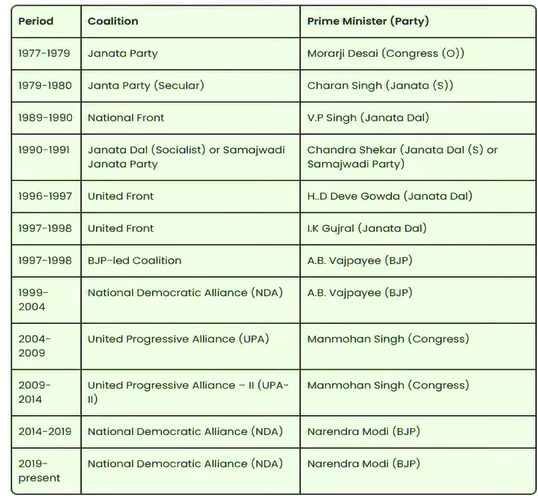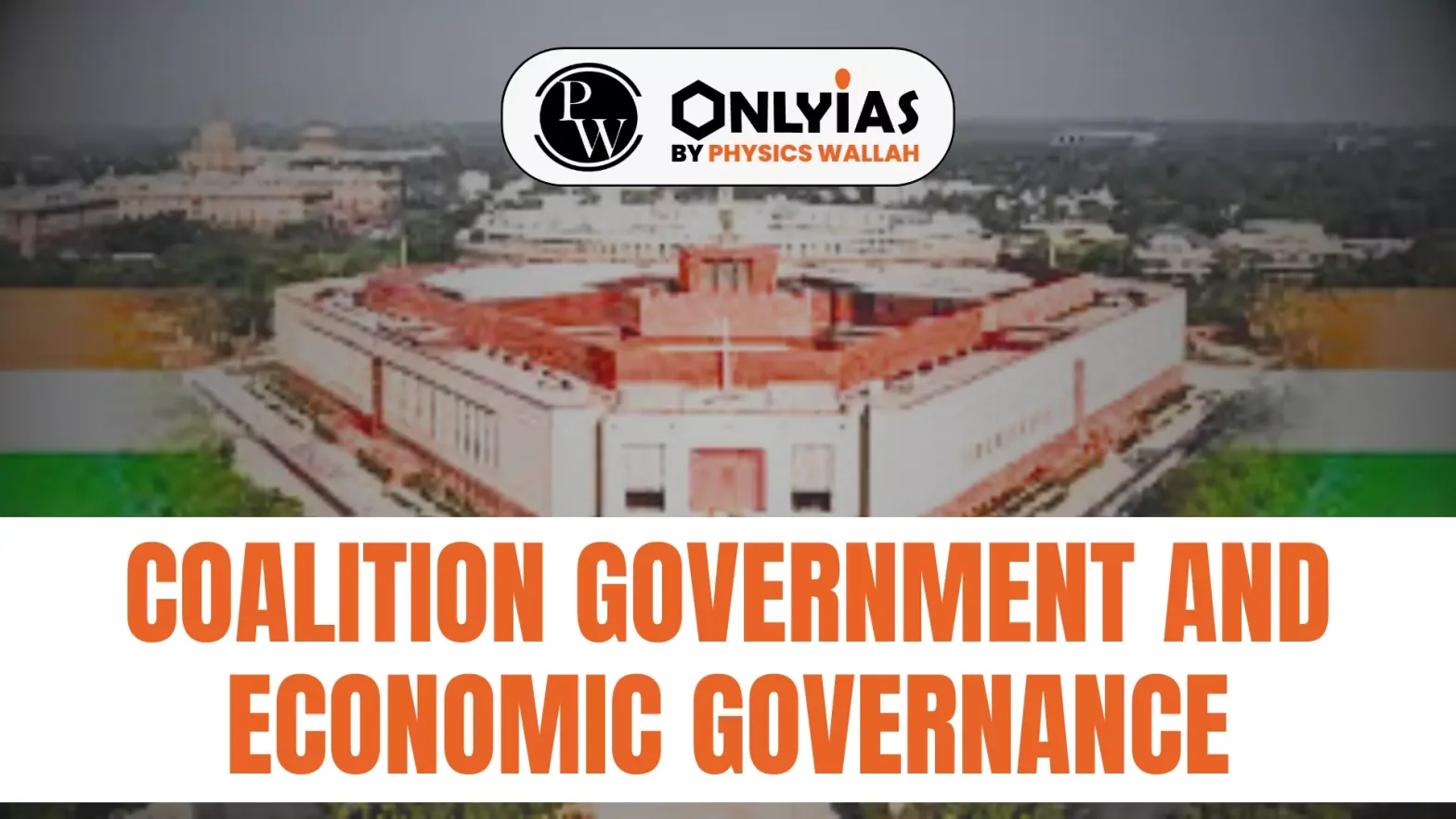Recently, the National Democratic Alliance (NDA) has returned to power for a historic third straight term at the Centre, but the Bharatiya Janata Party (BJP) itself has fallen short of the majority mark of 272, which implies there will be a coalition government.
| Relevancy for Prelims: Coalition Government And Economic Governance, Notable Reforms brought by the Previous Coalition Governments.
Relevancy for Mains: About Coalition Governments, Merits and Demerits of Coalition Governments, Significant Reforms Brought by Coalition Governments, etc. |
Meaning of Coalition Government
- Coalition: The term ‘coalition’ is derived from the Latin world ‘coalitio’ which means ‘to grow together’. Thus, technically, coalition means the act of uniting parts into one body or whole. Politically, coalition means an alliance of distinct political parties.
- Coalition Government: A coalition government is one in which multiple political parties come together and often reduce the dominance of the party that has won the highest number of seats.
- Coalition Formation: Coalition usually occurs in modern parliaments when no single political party can muster a majority of votes. Two or more parties, who have enough elected members between them to form a majority, may then be able to agree on a common programme that does not require too many drastic compromises with their individual policies and can proceed to form a government.
- Coalition governments are formed as seldom does a political party win the necessary number of seats to form the government on its own.
- First in India: In India, the first coalition government to complete its full-term was the Atal Bihari Vajpayee-led National Democratic Alliance from 1999 to 2004.
- Implications: While some say that coalition governments generate more inclusive policies, others believe that coalitions impose constraints on policy making.
- In the words of Montek Singh Ahluwalia (former Deputy Chairman of the erstwhile Planning Commission), a coalition government is a strong consensus for weak reforms.
Enroll now for UPSC Online Course
Notable Reforms brought by the Previous Coalition Governments
By looking back at India’s economic history since 1991, it becomes clear that coalition governments have undertaken some of the boldest and most visionary reforms that laid the foundation for India’s resurgence.

- Under the PV Narasimha Rao-led Government: It discarded centralized planning and opened the Indian economy to global completion by removing the license-permit raj. The country also became a member of the World Trade Organisation.
- Since 1991, when India was forced to open up its economy and give up on the planned economy model, all governments were coalitions of the sort where even the lead party was quite far from the majority mark.
- Under the short-lived Deve Gowda Government: It came out with what is still referred to as the “dream budget”. It placed faith in the Indian taxpayers and cut tax rates – both personal income tax, corporate taxes, and customs duties.
- Under the Atal Bihari Vajpayee-led Government: It framed the Fiscal Responsibility & Budget Management (FRBM) law for fiscal rectitude, and limited the government’s ability to borrow within prudential limits.
- It further advanced the push towards disinvestment of loss-making Public Sector Undertakings (PSUs).
- It focused on boosting rural infrastructure and connectivity through the PM Gram Sadak Yojana.
- It also brought in the Information Technology Act, in 2000, that laid the foundation for the bustling e-commerce giant that India is today.
- Under the Manmohan Singh-led Government: It brought in several reforms under the rights-based approach – far more robust than the personal guarantees of an individual leader.
- The RTI ACT 2005, which boosted transparency in India’s democracy.
- The Right to Food, which ensured that no Indian should go hungry.
- It brought in the Mahatma Gandhi National Rural Employment Guarantee Act (MG-NREGA), which provided minimum employment to the rural poor.
- It also deregulated fuel prices before it left office and started work on direct benefit transfers as well as Aadhaar and GST.
The Statistics
- The average growth rate for the 10-year period for the BJP-led majority government was 6%, including the 5.8% contraction the economy witnessed in FY21 amid Covid-related disruptions.
- The government achieved an average 7.4% annual growth in its first term between 2014 and 2019 – the fastest since 1989, when the coalition era started – growth rates under coalitions.
- The Congress-led United Progressive Alliance (UPA) government that preceded the BJP government in 2014 secured 6.7% growth in its five years, and 6.9% in the previous five years of its first term.
- The compound annual growth rate (CAGR) during the 10-year rule of the UPA at 6.8% was the fastest in India’s history.
- Growth averaged 5.6% between 1991, when the Congress led by PV Narasimha Rao formed a minority coalition with Janata Dal, and 1999 when Atal Bihari Vajpayee-led NDA returned to power for its full five-year term.
Check Out UPSC CSE Books From PW Store
Merits of Coalition Governments
- Accommodation of diverse interests: Example: The United Progressive Alliance (UPA) government (2004-2014) included parties like the DMK, NCP, and RJD, representing different regions and interests.
- Representation of popular opinion: Example: The National Front government (1989- 1990), led by V.P. Singh, was a coalition that represented the anti-Congress sentiment prevalent at that time.
- Consensus-based politics: Example: The National Democratic Alliance (NDA) government (1999-2004) under Prime Minister Atal Bihari Vajpayee built consensus among its coalition partners on key issues like foreign policy and economic reforms.
- Strengthening of federal fabric: Example: The UPA government’s decision to create the Telangana state in 2014 was a result of the pressure from its coalition partner, the Telangana Rashtra Samithi (TRS).
- Reduced chances of despotic rule: Example: The Janata Party government (1977-1979) was a coalition that came to power after the Emergency, effectively ending the single- party dominance of the Congress.
Demerits of Coalition Governments
- Instability: Example: The Charan Singh government (1979) lasted only for a few months due to the withdrawal of support by the Congress party.
- Curtailed leadership of the Prime Minister: Example: Prime Minister Manmohan Singh (2004-2014) often had to consult and accommodate the views of coalition partners like the DMK and the Trinamool Congress on key policy matters.
- Undermining of cabinet’s role: Example: During the UPA government, the National Advisory Council (NAC), headed by Sonia Gandhi, was seen as a parallel power center, undermining the role of the cabinet.
- Smaller parties playing ‘king-maker’: Example: In the 1996 general elections, the Haryana-based Haryana Vikas Party, with just one MP, played a crucial role in the formation of the government by extending support to the BJP-led coalition.
- Regional parties bringing in regional factors: Example: The Dravida Munnetra Kazhagam (DMK), a key coalition partner in the UPA government, often pressured the central government to take a favorable stand on issues related to Sri Lankan Tamils.
- Lack of responsibility for failures: Example: During the 2G spectrum scam in 2011, coalition partners of the UPA government, like the DMK, tried to distance themselves from the scandal, blaming the Congress party for the lapses.
Conclusion
Coalition governments in India, despite their challenges, have historically driven significant reforms and balanced diverse interests, contributing to robust economic and social progress.
Enroll now for UPSC Online Classes
![]() 6 Jun 2024
6 Jun 2024


